The Health Benefits of Kale
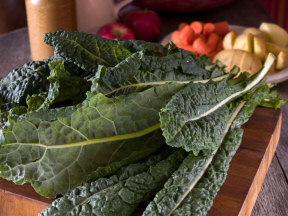 Kale is known as “Queen of Greens”, “New Beef”, and “Nutritional Powerhouse".
Kale belongs to the cruciferous vegetable family, the same as collards and
broccoli. Even though you can find Kale throughout the year in markets, the
main season for Kale is between mid-winter to the beginning of spring. Both the
taste and availability is highest during Kale's prime season. It is easy to grow
Kale and it grows well in colder climates that are less susceptible to frosts. Kale is known as “Queen of Greens”, “New Beef”, and “Nutritional Powerhouse".
Kale belongs to the cruciferous vegetable family, the same as collards and
broccoli. Even though you can find Kale throughout the year in markets, the
main season for Kale is between mid-winter to the beginning of spring. Both the
taste and availability is highest during Kale's prime season. It is easy to grow
Kale and it grows well in colder climates that are less susceptible to frosts.
The major varieties of kale are curly, dinosaur, tuscan, lacinato, and ornamental Kale.
Though a few more varieties are also available. Each
variety of Kale has its own distinct appearance, texture, and taste. The
botanical name of Kale is Brassica oleracea.
Curly Kale has a lighter green color
with a pungent flavor and is similar to a bitter pepper.
Curly Kale:
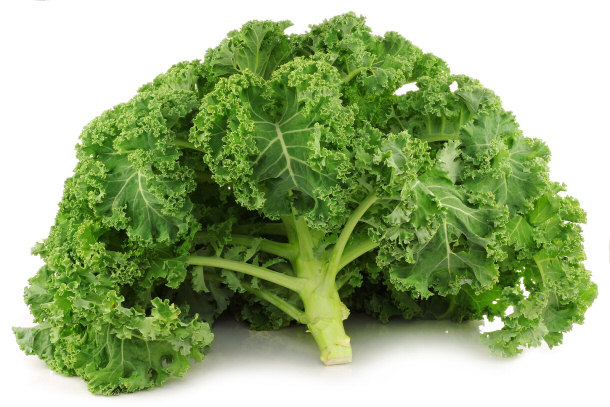
Ornamental Kale has
leaves with colors in green, purple, or white. This has a tender texture and a
mellow flavor. This type of kale is the least used for eating.
Ornamental Kale in Bloom:
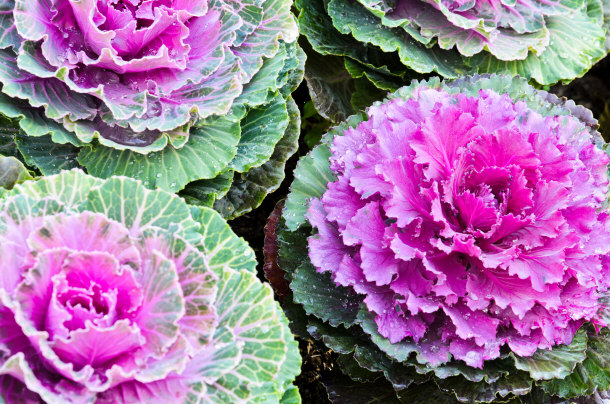
Dinosaur Kale has leaves that are blue-green in color and have
embossed textures. It is sweet and delicate in taste. Dinosaur kale is the
most popular form of kale for eating.
Dinosaur Kale:
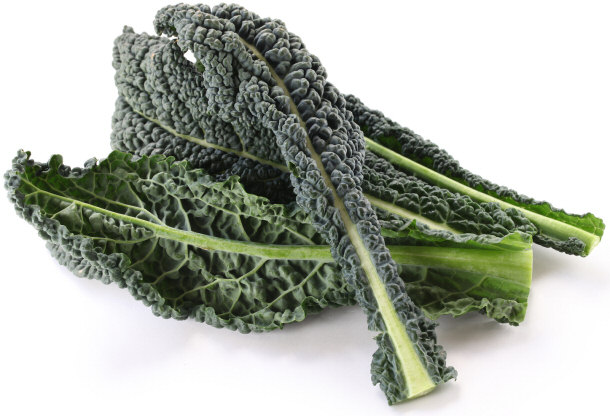
Health Benefits of Kale
1) Kale Has a Great Nutrient Profile
Kale has a high fiber content, does not have any fat content, and is low
calorie. One cup of Kale contains 5 grams of fiber, zero fat, and 36 calories.
Due to its rich fiber content, digestion improves and patients tend to have
healthier digestive tracts. Kale also contains several other useful nutrients, along with essential
vitamins, magnesium, and folate.
2) Kale Has High Iron Content
The iron content in Kale per calorie is more than the iron present per
calorie in beef. Iron is very good for health, since it augments the formation
of enzymes and hemoglobin in your body. Moreover, iron helps in good cell
growth, transportation of oxygen to all the parts of your body, proper liver
function, as well as a healthier immune system.
3)
Kale Is a Great Source of Vitamin K
Another major ingredient of Kale is vitamin K. Studies reveal that Kale
reduces the risk of at least five types of cancer: namely, breast cancer, colon
cancer, prostate cancer, ovary cancer, and cancer of the bladder. The glucosinolates present in Kale generate isothiocyanates (ITCs), which are
believed to play a key role in lowering cancer rates. Further, vitamin K also
improves a wide range of bodily functions, such as preventing blood clots and
the maintaining healthy bones. Additionally, it has been found that higher
levels of vitamin K can help those suffering from Alzheimer’s disease, providing
them with benefits that even include partial recovery of neurogenesis.
4) Kale Has Powerful Antioxidants
Kale is full of powerful antioxidants. It is a known fact that
antioxidants like flavonoids and carotenoids offer protection from several types
of cancer. Researchers have identified more than 45 flavonoids in Kale, with
quercetin and kaempferol heading the list of flavonoids. All the flavonoids in
Kale have anti-inflammatory and antioxidant benefits combined in them. Hence,
they offer a lading dietary role for Kale in avoiding oxidative stress and
chronic inflammation.
5) Kale Has Great Anti-Inflammatory
Benefits
Kale is an ideal anti-inflammatory food item. It has been estimated that
one cup of Kale contain 10% of the important RDA of omega 3 type fatty acids,
which are helpful in fighting asthma, arthritis, and other autoimmune diseases.
6) Kale Reduces Cholesterol Levels
Kale provides excellent support for patients suffering from cardiovascular
disorders, since Kale reduces cholesterol levels.
|
Bowl of Healthy Baked Kale Chips:
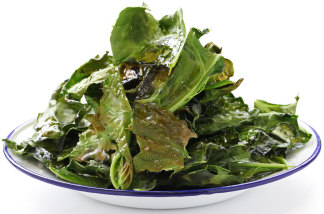
|
7) Kale Has Plenty of Vitamin A
The vitamin A content of Kale is quite significant. Not only does vitamin
A prevent oral cavities and different forms of lung cancer, but it also improves
your vision. Furthermore, vitamin A is useful in maintaining healthy skin.
8) Kale Has High Amounts of Vitamin C
The vitamin C content of Kale is also high, boosting your body's immune
system, hydration, and overall metabolism. Additionally, vitamin C helps in
improving joint and cartilage flexibility.
9) Kale Is a Great Source of Calcium
The high level of calcium in per calorie of Kale compared to milk is a
great aid in prevention of bone loss and osteoporosis, as well as maintaining a
healthy metabolism.
10) Kale is a Great Detoxifier
Kale is a very beneficial at detoxifying the body. The rich level of fiber and sulfur
in Kale leads to amazing detoxification results. They also improve the overall
health of your liver. The latest research has shown that the ITCs generated by
the glucosinolates present in Kale are useful in regulating detoxifying at the
genomic level. Moreover, Kale favorably modifies both phase I and phase II detox
steps.
Kale also contains high amounts of chlorophyll, which also is great for
detoxifying the body. Chlorophyll is the deep green pigment that you see in Kale. Chlorophyll
is also great for purifying the blood.
Due to these huge health benefits, you should highly consider consuming Kale and other cruciferous
vegetables at least 2 to 3 times every week as part of your regular diet. Each serving of
Kale should be a minimum of 1½ cups. In fact, you could increase the intake of
Kale to 4 to 5 times a week and the serving size to even 2 cups to reap even
more health benefits from Kale.
Storing Kale
You should not wash Kale before storing it in refrigerator, since water
exposure encourages spoilage. When storing it in the refrigerator put it in an
air tight plastic bag up to 5 days.
Preparation of Cooking Kale
Start off by rinsing kale under running cold water before using it for
cooking. You should cut the leaves of Kale into one-half inch slices and cut the stems
into one-quarter inch length. You should keep them in this cut position for a
minimum of 5 minutes to increase their health promotion qualities and then steam
cook them for 5 minutes. You could also sprinkle the cut pieces of Kale with
lemon juice and keep them for 5 minutes before steam cooking them. In just one
cup of cooked Kale, which is about 130 grams, both the daily percentage value of
nutrients as well as massive health benefits can be gained.
If you steam cook Kale, it offers unique cholesterol lowering benefits. The
steaming process helps in binding the bile acids present in your digestive track
with the rich fiber contents present in Kale. When you consume steam cooked Kale
extracts the bile acids act more powerfully. This binding process causes more
cholesterol to be lost in the body so patients will have much healthier results.
Bowl of Steamed Curly Kale:
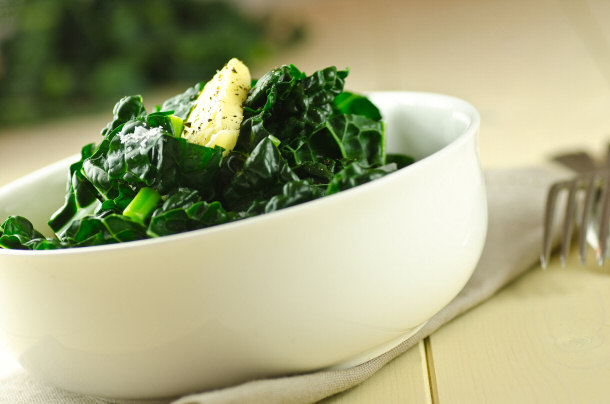
Use Kale for Juices and Smoothies
Kale makes a great complement for juices and smoothies. When using them
in smoothies leave out the stem so it will have a better texture. Juicing
kale along with other healthy produce is a great way of getting all of kale's
health benefits.
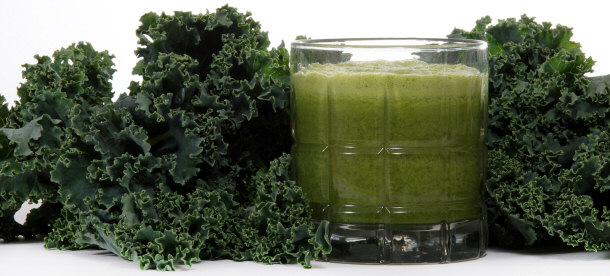
Opt for Organic Kale
Kale is a great example of a produce that should be
bought organic instead of conventional. Like most green leafy plants,
choosing organic ensures you that the pesticide content will be dramatically
lower, along with a higher nutrient density.
Conclusion
Since Kale is a green vegetable it is extremely healthy, and adds
essential vitamins and minerals to your diet. Kale can be chopped and eaten like
other vegetables or it can be made into a juice/smoothie. It has powerful
anti-oxidants that can prevent cancer and other serious diseases. Kale is also
great at flushing out your system, effectively cleansing the body of all sorts of
contaminants. It can prevent cataracts and is very beneficial to your
cardio-vascular system. It has anti-inflammatory benefits and can reduce or heal
arthritis. Kale has Lutein properties in it, which is an anti-oxidant used to
protect the skin from ultraviolet rays as well as promoting visual health.
Diet & Nutrition
Top Lists:
Top 15 Foods That Help Migraines
24 Food Additives That You Should Consider Avoiding
Top 15 Healthy Spices From India
15 Disgusting Ingredients In Your Food
15 Best Foods For Brain Health
15 Foods That Are Surprisingly Good for You
Top 15 Organic Produce That's Better Than Conventional
15 Weird Interesting Facts About Vegetables
10 Best Cleansing & Detoxifying Foods
Informational:
Evaluating Diet Plans: Which One is Right for You?
The Essential Health Benefits of Ginger
The Health Benefits of Kale
Top Natural Appetite Suppressants That Will Help You Lose Weight
Almond: The Magic Pill For Hunger, Weight Loss and Cholesterol
How Effective is Phen375 in Losing Fat?
What Are Health and Losing Weight Benefits of Unique Hoodia?
Organic Foods – Are they better than Conventional Foods?
Facts about Alcohol
Best Ways to Get a Good Night’s Sleep
General Benefits of Green Tea
Health Benefits of Inositol Supplements
Anti-Aging Foods to Stay Young
Who is Responsible For Overweight Children?
My Secret to Losing 100 Pounds in 6 Months
How and When to Use HCA Extract? |